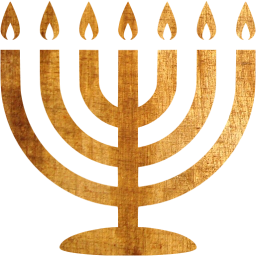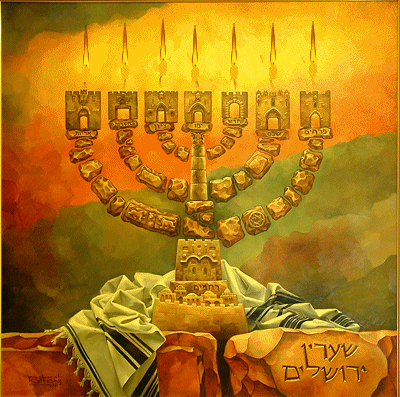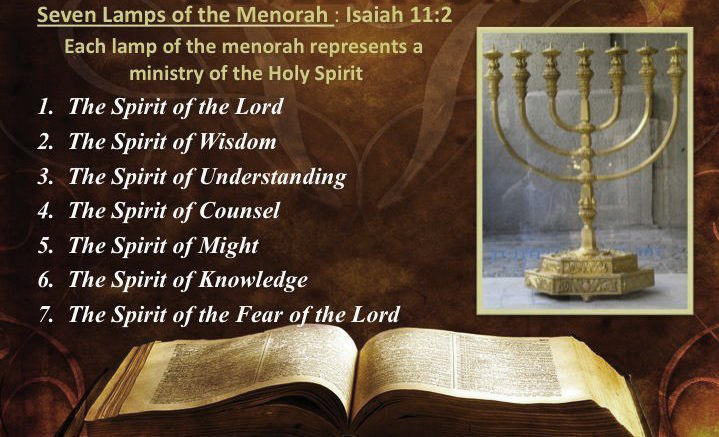The Menorah

One of the oldest Biblical symbols is the Menorah, a seven-branched candelabrum used in the Temple. The kohanim (priests) lit the menorah in the Sanctuary every evening and cleaned it out every morning, replacing the wicks and putting fresh olive oil into the cups.
The Only Symbol
It has been said that the menorah is a symbol of the nation of Israel and our mission to be “a light unto the nations.” (Isaiah 42:6). The sages emphasize that light is not a violent force; Israel is to accomplish its mission by setting an example, not by using force. This idea is highlighted in the vision in Zechariah 4:1-6. Zechariah sees a menorah, and YHWH explains: “Not by might, nor by power, but by My spirit.”
All other “religious” symbols in the world are man-made and have no real significance.
Even the cross displayed in Catholic and Christian churches around the world is a pagan symbol as it represents the way the ancient Romans used to put people to death. Our Messiah -Yahushua was tortured and killed on this hideous man-made instrument of death, so why would anyone want to keep its memory alive by turning it into an icon? It’s one thing to remember that our Saviour was killed on a stake/cross, but it’s quite another to turn it into an idol that features in churches, necklaces and bracelets, and even as tattoos on our bodies.
The Menorah, the only symbol our Creator designed Himself (all other “religious” symbols are man-made), is said to symbolise the burning bush as seen by Moshe on Mount Horeb (Exodus 3). YHWH commanded Moses to make a Menorah that had one main “stem” and six branches (Exodus 25:31-40); and commanded it to be placed in the “Set-apart place” of the Tabernacle and the Temple.
The Menorah with its seven branches is a perfect picture of the Seven Spirits of YHWH, as shown in the following scripture:
“The Spirit of YHWH shall rest upon him, the Spirit of Chochmah (Wisdom) and Binah (Understanding), the Spirit of Atzah (Counsel) and Gevurah (Might), the Spirit of Da’at (Knowledge) and of the Yirah (Fear) of YHWH.”
Isaiah 11:2-3
The center of the menorah represents the Spirit of YHWH while the six other attributes are joined into the center pillar. These seven Spirits also signify perfection or completeness. The Fear of YHWH Elohim is a “Spirit” of YHWH; it is a vital spiritual quality for Life in Mashiach. The Fear of YHWH is a personal guide. The Hebrew word ‘yirah’ means fear, as in fear/awesome/terrifying contrary to Christian teaching that the Fear of YHWH is not really “fear” but love and respect.
Isaiah 29:13 reveals how “the Fear of YHWH is taught by the precept (a general rule intended to regulate behaviour or thought) of men”; in other words, man’s religious theology and tradition has made void the Fear of YHWH. Many Christians prefer the term “reverence” over “fear”; Christians also use a title of “Reverend” for their clergymen and ministers; therefore, the term “Fear of YHWH” was first negated and then given a theological/semantic twist to apply to their own leadership, as in the case of “reverend.”
The Fear of YHWH is noted throughout Scripture; Genesis 20:11; 42:18; Exodus 9:30; 18:21; Leviticus 25:17; Deuteronomy 10:12 and in more than a hundred places. Without the Spirit of the Fear of YHWH, people will fear man, materialism, relativism and all form of idols, including their religious leaders. The Fear of YHWH empowers Y’shua’s followers to uphold the Word of YHWH, regardless of consequences (see Romans 3:18; 2 Corinthians 5:11; 7:1; Ephesians 5:21; Revelation 15:4).
THE REVELATION OF YAHUSHUA MESSIAH… These are the opening words to the last book of Scripture (Revelation.1:1). They leave no room for doubt as to the results desired by its author which is a complete exposition of every facet of our Master’s triumphant ministry. An exposé of the all encompassing effects of his Judean ministry on the eternal scene is the objective. Still, a recent survey indicates that many laymen find this book too mystical to be appreciated. Some scholars are now giving it second-class billing in importance for study, considering any interpretation of it to be purely speculation or conjecture and therefore too controversial. Some pastors and religious educators boast of deleting it entirely from their teaching agenda. What accounts for this? Why the apparent paralysis of interest and prevailing difficulty in appreciating the content of this book with such lofty introduction?
One major cause for the limited understanding of this book’s content is the prevailing unfamiliarity of the average Christian with *Biblical Judaism and its accompanying symbols. The *Menorah (lampstand) is one of those important Hebraic symbols.
* Biblical Judaism – Here we make a distinction between “Torah-centric Judaism” [Biblical] and “Rabbinic Judaism” [Talmudic.] A Torah-centric Judaism was the religion out of which the first century church grew maintaining it’s biblical contours in the faith and theology of Israel.
*Menorah: The Hebrew term for the seven branched lampstand.
Why is it so important to understand the Jewishness of this book that some refer to as the “Readers Digest” of Scripture? Dr. John Walvoord of Dallas Theological Seminary has noted that “Of the 404 verses of the Apocalypse, 278 are direct quotes from [Torah], Hebraic Scripture.”
Unfortunately, historic efforts to delete everything “Jewish” from the doctrine, liturgy and symbolism of the first century church and from Biblical expression has contributed to a certain interpreting handicap. The absence of this all important dimension has left the church ill equipped to understand many of this book’s Hebraic expressions and symbolic references. It has deprived us of some richness of understanding that would otherwise be available if the Revelation of Y’Shua ha Mashiach, and the entirety of Scripture for that matter, was interpreted from a Hebraic mind-set.
Symbols such as the Menorah are not Jewish in an ethnic sense, nor even Christian in a religious sense, but they are simply Biblical in a divine sense, and therefore eternal and universal (for everyone).
The book of Revelation is in large part a book of symbolism. Those who would minimize the importance of symbolism minimize not only the importance of that book but the entirety of scripture. Symbolism plays a crucial role in Biblical revelation and interpretation. One of the first symbols encountered as we begin reading the book of Revelation is the seven-branched Menorah. Y’Shua [the Son of man] is observed in the midst of seven of them.
And in the midst of the seven lampstands One like the Son of Adam . . .
Revelation 1:13
These lampstands were not just seven isolated singular candles as one might suppose at first glance, but they are seven Menorahs – YHWH’s idea of a lampstand. Immediately we are informed that the lampstands represented the Judeo-Assemblies of Asia:
“The secret of the seven stars which you saw in My right hand, and the seven golden lampstands: The seven stars are messengers of the seven assemblies, and the seven lampstands which you saw are seven assemblies.
Revelation 1:20
This declaration therefore, by association, makes the lampstand a Judeo-Christian symbol and representative of New Testament believers. It is important that believers perceive the all-encompassing message embodied in the Scriptural lampstand. You may be surprised how up-to-date this symbol of antiquity really is. Christians would do well to become better informed on this aspect of Scriptural heritage in symbolism. The Scriptures teach that the Menorah was and is esteemed of YHWH a symbol extraordinaire. Indeed it has been referred to in Scripture as the “Lamp of YHWH.” If it is, then YHWH’s people should embrace it and perceive the lessons embodied therein.
The Lamp of YHWH

And thou shalt make a candlestick of pure gold: of beaten work shall the candlestickbe made: his shaft, and his branches, his bowls, his knops, and his flowers, shall be of the same.
And sixbranches shall come out of the sides of it; three branches of the candlestick out of the one side, and three branches of the candlestick out of the other side:
Three bowls made like unto almonds, with a knop and a flower in one branch;and three bowls made like almonds in the other branch, with a knop and a flower: so in the six branches that come out of the candlestick.
And in the candlestick shall be four bowls made like unto almonds, with their knops and their flowers.
And there shall be a knop under two branches of the same, and a knop under two branches of the same, and a knop under two branches of the same, according to the six branches that proceed out of the candlestick.
Their knops and their branches shall be of the same: all it shall be one beaten work of pure gold.
And thou shalt make the seven lamps thereof: and they shall light the lamps thereof, that they may give light over against it.
And the tongs thereof, and the snuffdishes thereof, shall be of pure gold.
Of a talent of pure gold shall he make it, with all these vessels.
And look that thou make them after their pattern, which was shewed thee in the mount.
Exodus 25: 31-40
Divine Design
The Menorah an ever present symbol of truth – The Apostle Paul expressed it unequivocally:
For since the creation of the world His invisible qualities have been clearly seen, being understood from what has been made, both His everlasting power and Mightiness, for them to be without excuse, …
A Unique Lampstand
Here the Menorah becomes identified as “THE LAMP OF ELOHIM”. As such, the Menorah is a timeless symbol. This seven-branched lampstand, for many Christians (if recognized at all) has been regarded as little more than a Jewish relic. However, this YHWH given symbol should not be considered something “out of date” nor simply Jewish but divine and therefore timeless. Notice in the foregoing Scripture that the Menorah was not referred to as the “Lamp of the Jews” or the “Lamp of the Temple” nor the “Lamp of the Synagogue” but the LAMP OF ELOHIM. Why? Because it was YHWH ELOHIM who designed it, had it constructed, and commanded its use (Ex 25:31, Number 8:2-4).
The lampstand, perhaps better than any other item that YHWH commanded Moshe to make, serves the ends and purposes of revelation by symbolism. We will discover that the Menorah symbol regularly surfaced in the spiritual experiences of many other prophets and visionaries as it did with Samuel. Notice the circumstances surrounding Samuel’s prophetic call and the existing condition of Israel. The lamp of YHWH was going out and soon afterward the Philistines captured the Ark of the Covenant. Eli, the judge and High priest of Israel, had died and a child was born to Phinehas his son who’s name says it all, Ichabod meaning “The glory of YHWH has departed.” In principle this story could very well parallel many of the conditions within the Assemblies/Church in history and serve as a prophetic picture of our own time. The setting was at evening time, the light from the Lamp of YHWH was shining less brightly in the temple and there was “no open vision” (revelation). It is very unusual that the lamp of YHWH would have been going out at the very time of day when it normally should have been freshly fueled and burning its brightest. The Church can learn valuable lessons from this story. We could very well be approaching the end of the age (evening). The Lamp of YHWH, which is the Word of YHWH (Psa. 119:105) and our understanding of it, has been seriously eroded due in great part to our forsaking the foundations of our faith rooted in the Hebrew heritage. The judgment of YHWH is impending as Yahushua predicted.
Deuteronomy 32:2-3
And you children of Tsiyon, be glad and rejoice in YHWH your Elohim, for He shall give you the Teacher of Righteousness, and cause the rain to come down for you, the former rain and the latter rain, as before.
This refreshing rain of truth for the work of restoration and renewal is central to YHWH’s strategic plans. It will cause the lampstand (Church) to be ablaze with the light of absolute truth. We should pray earnestly for “rain in the time of the latter rain” (Zech. 10:1). Let it become a continuous theme in the prayer life of us all. We must shine forth as lamps in a world of darkness
It was at evening time when the lampstand was refueled for greater burning in the Temple. If we are indeed in some close proximity to the end of the age it is “lamp trimming time.” In other words, it is ‘Scripture research time’ for the body of Messiah:
There is a beautiful Hebrew idiom that suggests: “Study is the highest form of worship.” Believers/Christians would do well to grasp the richness of that philosophical truth. If we are to shine forth as lamps in a world of darkness as Y’Shua indicated (Luke 12:35), YHWH’s word must become very precious to us and an accelerated understanding of it a high priority. Apathy toward truth is undoubtedly one of the subtle sins of our time. It is this condition that YHWH is presently addressing so that His people are motivated toward a restoration of all things Scriptural. The Apostle Peter confirmed explicitly on the day of Pentecost what Y’Shua taught us in the parable of the virgins:
Candle Power
Matthew 5:14-17
The church here is represented by the symbol of the candlestick. The lesson is that the Church must become the light of the world (a reflection of the Word of YHWH). The book of Revelation gives substantial affirmation to this assertion when the angel states:
None of these practices were foreign to the first century congregations. It should therefore come as no surprise to discover that the Menorah symbol was on display within these Assemblies in Asia. Their understanding of these Scriptural things is assumed in these letters. That no doubt accounts for the abundance of Judaic expression in the book of Revelation.
The circumstances and the particulars of the lampstands mentioned early on in the book of Revelation merit investigation. In the first chapter, we discover the Son of Man (Yahushua) in the midst of the seven golden lampstands. What does this mean? Since we have learned that the lampstands represented the assemblies, we must conclude that it depicts those assemblies wherein the spirit of Messiah is truly alive and motivating. The overriding theme of the angelic cry to the seven assemblies of Asia was not redemption, but restoration to a Messiah-like spirit and Scriptural order. Paul alludes to this in his letter to the Galatians:
The Spirit of Prophecy
The Seven Spirits

Conclusion
The cross would bring back haunting memories of excruciating torment as is indicated by the writer of Hebrews when he states that our Saviour “endured the stake despising the shame” (Heb. 12:2). Perhaps this is why the cross is so glaringly missing, indeed totally absent, from the abundance of symbolism to be found in the book of the “Revelation of Yahushua Messiah.” It is simply nowhere there to be found.
On the other hand, He would no doubt be heartened and thrilled at the sight of the golden lampstand, which is so profoundly meaningful in the revelation of who He is in the power of His resurrection and the light of His presence. As we more fully appreciate the significance of this magnificent symbol, we will join with the angel to declare:
“NOT BY MIGHT, NOR BY POWER, BUT BY MY SPIRIT SAID YHWH OF HOSTS” (Zec 4:6).
Y’Shua said that we were to be the “light of the world.” And that we were to put our light on a lampstand (Mt. 5:15).
Y’Shua is the light that lighteth every man that cometh into the world.
Now we are to be the light to the world – as we reflect the full light of the menorah, with YHWH/Y’Shua at the centre of our light.
Amein!
(Ref. from Rev. 4:5, Isa. 11:1-2, Jn. 1:9, Mt. 5:14, Ph. 2:15, Ps 27:1)
“Let your light so shine”
Explore
